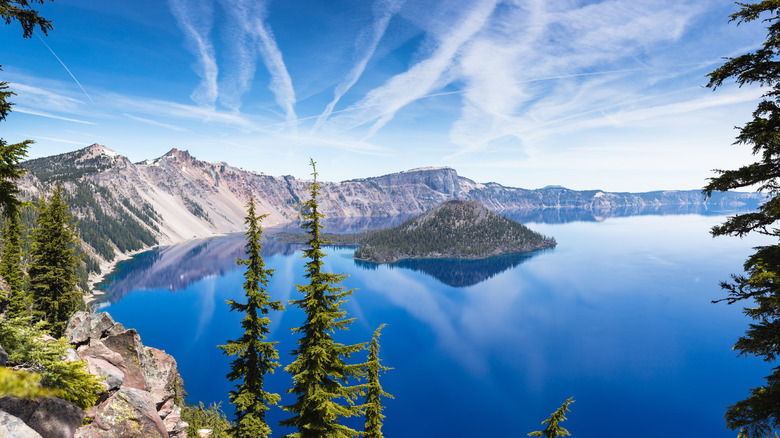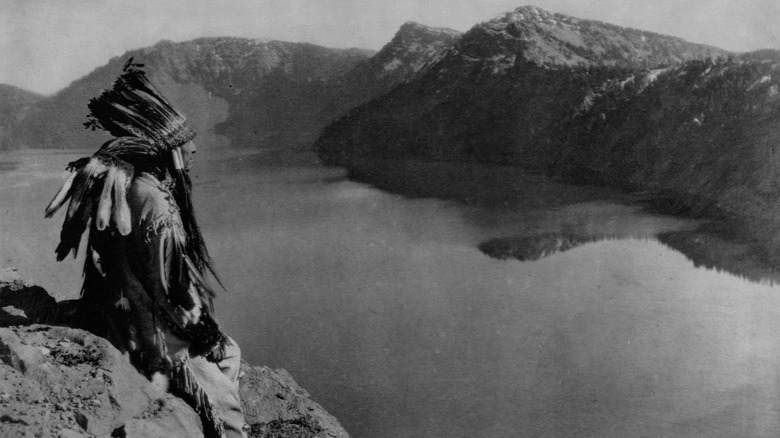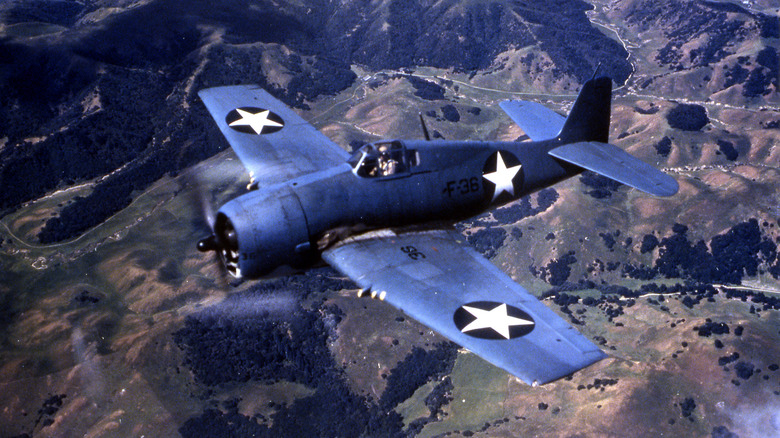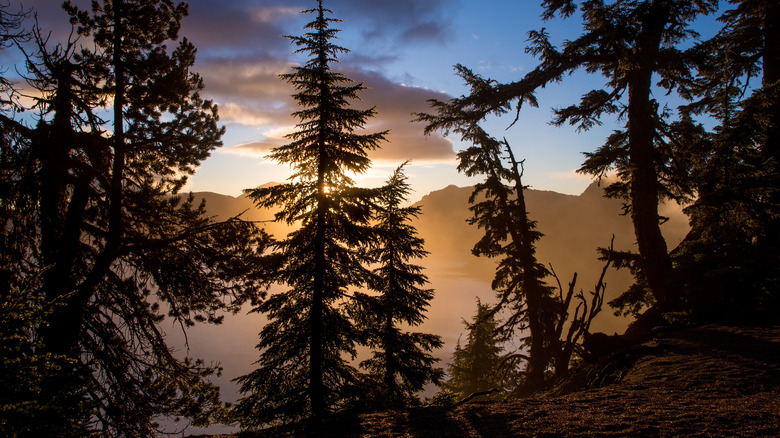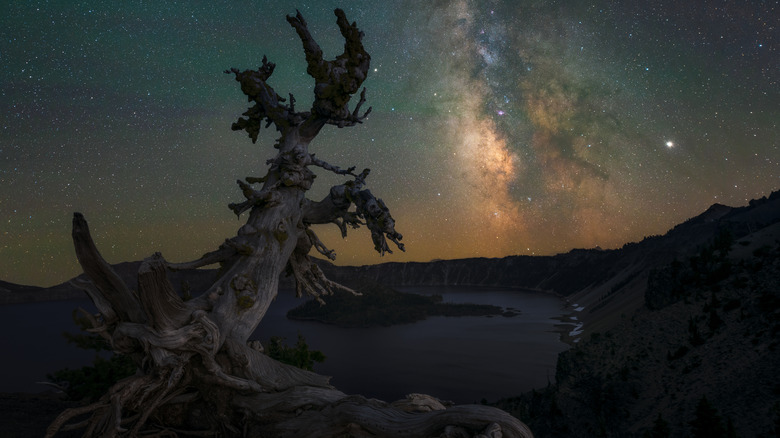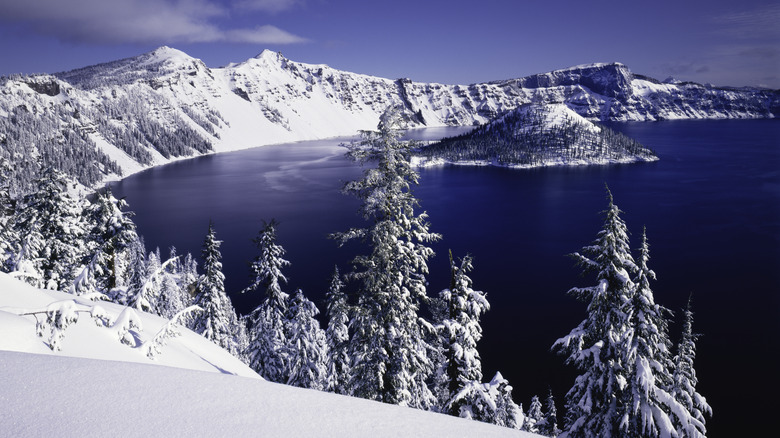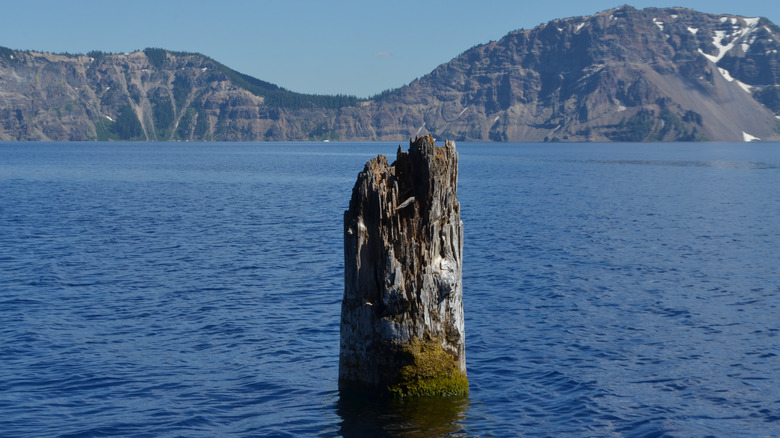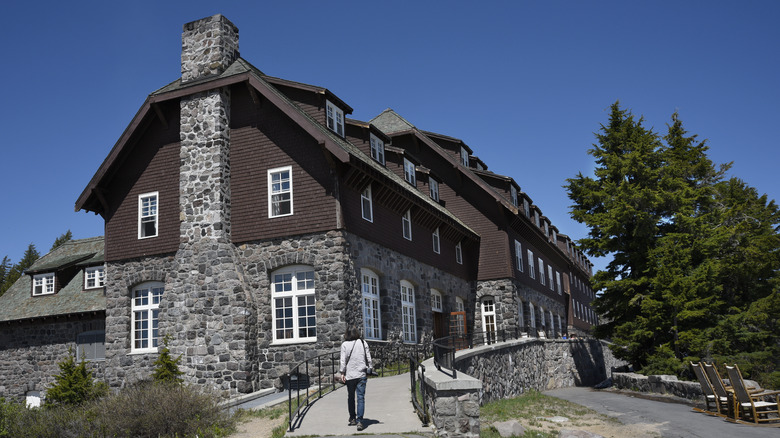A Look At Crater Lake's Morbid History
Located in southern Oregon, Crater Lake is the crown jewel of Crater Lake National Park. It formed in the caldera left behind by a massive volcanic eruption 7,700 years ago and is now recognized as the deepest lake in the U.S., with an average depth of 1,500 feet. Smaller eruptions formed Wizard Island, an old volcanic cone rising out of the clear, cold water. Crater Lake is, to many, glory to look upon, yet the history of the park is darker. The water and its environs have seen a shockingly sad past full of violence, accidental death, and tragic disappearances (not to mention reports of lake monsters, UFOs, and Bigfoot).
But these dramatic stories require skepticism. Take the tale of John Wesley Hillman, the first known white person to see the lake in 1853. Some stories will have you believe that he was part of a search party that found missing miners and a lost gold mine they had just uncovered. Alas, Hillman plummeted off a cliff on his way back to civilization. Only, Hillman actually died in 1915 at age 82 in Baton Rouge, Louisiana. Hillman was indeed part of a group that got lost while searching for this quasi-mythical mine, and he did claim that his mule kept him from plummeting off a cliff near the lake, but that's about it.
Yet, even a look at the real stories reveals a truly unnerving past for this beautiful national park. Here's some of the morbid history of Crater Lake.
Indigenous people have said the lake holds threatening power
Native people definitely visited Crater Lake a long time ago, as evidence of human activity was found beneath a layer of volcanic debris deposited by the caldera-forming eruption of Mount Mazama about 7,700 years ago. Yet few have wanted to discuss the lake because it was said to be dangerously powerful.
According to oral histories of the Makalak people (whose descendants are now the Klamath), the spirit of Mount Mazama was an underworld figure called Llao. While surveying the area around the peak, Llao became enamored of a Makalak chief's daughter. When she declined to follow him into the underworld, he promised vengeance, and the mountain erupted. The sky spirit, Skell, protected the Makalak tribe from his own post atop Mount Shasta. Skell pushed Llao back into the underworld, causing Mazama to collapse into a caldera that became Crater Lake.
Other versions of the tale get gory, with Skell killing Llao and throwing his remains into the lake. Monsters ate most of Llao's body, but his head was left behind, and something of him is believed to still linger around the lake. Since then, at least some of the indigenous people in the area have come to believe that the lake is too powerful to linger near or even gaze at for too long. It's notable that the Klamath people have no legends about the waters themselves, as the lake-related stories seem to abruptly end after the destruction of the mountain.
Two planes went missing nearby in 1944
During World War II, Crater Lake saw multiple accidents involving U.S. military aircraft. One of the first recorded incidents concerned a pair of Grumman TBF Torpedo bombers flying near the lake in the spring of 1944. According to the surviving pilot, he turned to look for his partner and found only empty air. To the best of his knowledge, the other bomber had suddenly crashed into Crater Lake with no apparent signs of trouble. However, there are no known reports of anyone who saw the plane hit the water. The U.S. military reportedly kept the crash under wraps, believing that news of an aircraft accident involving one of its bombers would be a bad look while they were embroiled in a war.
Later that year, a military training aircraft also reportedly went down in the area, crashing while heading north and carrying both the pilot and a gunner. The wreckage and any human remains associated with it have not yet been found. Locals claimed airplane crashes in the region were common, perhaps due to new pilots, challenging terrain, or, as more eerie-minded folk may tell you, something ominous about the park and its lake.
A somewhat happier incident occurred in May 1945, when another Grumman Torpedo bomber is believed to have crashed into Crater Lake when its engine stalled. This time, the Navy pilot was able to safely get out of the craft and onto a raft, where he was eventually rescued.
Another missing fighter plane led to an eerie discovery
Missing person cases that linger without resolution are often haunting, but finding an end to the story sometimes paints a very unsettling picture. One of the most infamous cases, at least as far as Crater Lake is concerned, began on December 3, 1945. That day, a group of seven Grumman Hellcat fighter planes were headed north from California to Washington. While over the park, the group encountered heavy fog. When the squadron made it to clearer skies, they found that one aircraft, flown by 22-year-old Ensign Frank Lupo, was missing. Lupo had last been seen switching gas tanks mid-air, but something must have gone wrong in the attempt. The squad leader reported that the engine appeared to fail, and Lupo's plane quickly descended into the heavy cloud cover.
That was the last anyone saw of Lupo for nearly 25 years. Then, in August 1970, newly hired park ranger Dave Panebreaker was hiking in the park when he came across a human skull. As Panebreaker recalled in an oral history interview, he told the chief ranger about the find — then pulled the skull out of his backpack and placed it on his boss's desk. Naval investigators went back to the site and found the remains of a Hellcat fighter plane, including a piece of equipment with a serial number that matched Lupo's missing aircraft. Dental records confirmed that the skull belonged to Lupo, and his remains were returned to his surviving family.
Two 1952 murders still haven't been solved
While Crater Lake has seen perhaps more than its fair share of accidental deaths, it's also been host to some more intentional ends — namely, murder. In 1952, the remains of two General Motors executives were found in the park. Charles Patrick Culhane and Albert Marston Jones had been sightseeing while in the middle of a business trip. Earlier, local business friends of the pair found their seemingly abandoned car in a remote area of the park. Two days later, a man called a local garage and asked them to pick up a car from the same location. When police investigated, they found that he had given an alias and had disappeared from the train station where the call originated. Meanwhile, search parties had gone looking for the men, finding their decomposing bodies about a quarter mile into the forest, with gunshot wounds, numerous other injuries, and missing shoes.
Truck driver Lincoln Linse, who was on a delivery job in the park, reported seeing the two men hustled into the woods by two less-savory types, including a man with a distinctive forearm tattoo and a missing finger. Linse even believed he may have heard the gunshots that killed the men. However, despite an FBI investigation, the killers have never been found. Some believe that Culhane and Jones were victims of a robbery gone terribly wrong, while others speculated that it was a mob hit linked to union troubles.
One woman says she had a warning of her husband's death
Jean Nunn may have thought she was only seeing her husband fly off from the Klamath Falls airport that day in February 1975. After transporting their daughter and grandchild back to Salem, Oregon, two student pilots, Jim Pryor and Matt Perkins, would accompany Dave Nunn on his way back. Surely, she wasn't feeling too anxious, or else she wouldn't have been able to go to bed early that night.
But, as she told the Herald and News in 2007, she woke up at 9:30 in the evening with the feeling that someone had put a hand on her leg. No one was there. Jean knew then that something had happened to Dave. When she called the airport, she first told them that the plane must have gone off the radar just before 9:30. They confirmed that she was right. The plane had safely made its planned stop in Salem but disappeared from radar on the return trip at about 11,000 feet. Yet, while Dave and the two trainee pilots never made it back to the airport, no one found their remains or the plane for years. Some speculated that they had plummeted into the deep waters of Crater Lake, where other wrecks had disappeared.
It wasn't until July 1982 that a hiker just outside the park found the wreckage of Dave Nunn's small blue Cessna. Inside were the skeletal remains of Nunn, Pryor, and Perkins.
A photographer's remains were found in an odd state
Charles McCullar was a young man who, on January 29, 1975, left a friend's home in Eugene, Oregon to take a hiking trip to Crater Lake National Park. He told his friend that he expected to return a couple of days later. When McCullar still hadn't shown up by February 1, the friend contacted Oregon State Police to report him missing. The police then proceeded to drag their feet for two weeks, after which they finally learned that McCullar was seen at a store near the park the evening of January 29. His last known location was near the park at Stump Lake, where he was reportedly dropped off by a motorist on January 30.
On October 14, 1976, rangers were examining a heavily damaged backpack turned in by hikers a day before. The pack, found in a remote area of the national park, contained a Volkswagen key that matched one linked to Charles McCullar. That afternoon, rangers dispatched to the site found skeletal remains that were eventually identified as McCullar's. FBI investigators ruled that he died of natural causes.
But many questions remain. How could McCullar have walked through 105-inch deep snows some 14 miles into the park without gear like skis or snowshoes? Why was his expensive camera missing? What pushed him to take on such an arduous trek in the first place? Decades later, these questions remain unanswered and will likely remain so indefinitely.
A boy went missing without a trace
At Crater Lake National Park, one of the saddest and most confounding missing persons cases is surely that of Samuel Boehlke. Also known as Sammy, the eight-year-old boy was visiting Crater Lake with his father, Kenneth, in October 2006. Towards evening, the two stopped to play on a hill. Sammy refused to come down despite his father's urging. When Kenneth chased after him, Sammy ran ahead and disappeared over the top of the hill. Kenneth, and eventually the search parties that combed the area with scent-tracking canines and helicopters, never saw Sammy again.
Complicating matters was the fact that Sammy was on the autism spectrum. Loud noises and bright lights tended to push the boy into further hiding, which greatly complicated the search effort. His parents also told searchers that Sammy often liked to pack himself into small spaces, making it all the more difficult to spot the boy in the vast wilderness.
Dogs briefly picked up what might have been Sammy's scent, but it led nowhere. Given the few people in the park at that location and time of year, investigators also ruled out kidnapping. The search was eventually called off in November when snow began to fall in the park, and freezing temperatures made it all but certain that the boy did not survive. No trace of him has yet been found, and Sammy remains listed as a missing persons cold case by the National Park Service.
The Old Man of the Lake is an odd log
While it may not be strictly morbid, there's something oddly unsettling about a log in Crater Lake. Perhaps it's because the nutrient-poor lake is pretty bare of the usual plant matter that chokes other bodies of water (though some tough mosses do just fine in the deep levels of the lake). And there is only a decent fish population in the lake because humans began stocking the waters with them in the 19th century. So, what are the remains of a giant hemlock tree doing here?
Popularly known as the Old Man of the Lake, the long-dead, moss-clad, almost skeletal log measures some 30 feet long and floats vertically in the lake, with about three feet sticking above water (it used to be four, but weathering has whittled down the Old Man somewhat). First recorded in 1896, carbon dating gives the log an age of about 450 years. The federal government even studied its movements while it floated around the lake in 1938.
That may be exciting only to a few scientists, but there are odd stories about the Old Man that carry a more spine-tingling edge. Researchers surveying the lake bottom in 1988 anchored the log to Wizard Island. A nasty storm then blew up, followed by snowfall — in August. When scientists released the log, the weather turned back to normal. Coincidence, perhaps, but maybe the log has a little bit of the lake's eerie power for itself.
Only part of a 1995 helicopter crash has been recovered from the lake
Crater Lake National Park has been witness to a sad slate of plane crashes, but those aren't the only airborne craft (and their occupants) to meet sudden and tragic ends in the park. On September 23, 1995, a company helicopter dramatically crashed without any warning right into Crater Lake. Witnesses on the ground reported that the craft circled Wizard Island, then began to descend relatively slowly, until it finally hit the water and effectively disintegrated. The two people who had been inside, pilot George W. Causey and passenger Edward Tulleners Jr., both died. Neither of their bodies was ever found, though the helicopter did break into pieces and released about 70 gallons of fuel into the lake.
Aside from bits of debris that floated to the surface, the rest of the helicopter and any human remains that may have been inside it sank in about 1,500 feet of water. There was an attempt to salvage the wreckage — not least because federal law basically demanded the recovery effort — but next to nothing was found. Even an attempt to map the bottom of the tremendously deep Crater Lake in 2000 revealed no evidence of the lost craft. Though there's now no projected environmental impact on the lake and its surroundings, questions remain as to why the helicopter abruptly crashed in the first place.
A nearby lodge is said to be haunted
Is Crater Lake haunted? Some say that Wizard Island emanates unexplained smoke every once in a while, but that may be attributed to geological activity, wildfires, or even simple human error as much as ghosts. Stories from park employees may be more believable, as in the account of Ranger Jan Kirwan, who told National Parks Traveler that she has seen different instances of unsanctioned campfires in the park at night. But sometimes the spot where she saw towering flames and multiple people from a distance is, upon closer inspection, empty and cold.
Others say that Crater Lake Lodge is the most obviously haunted spot in the park, though facility engineer Craig Peterson told the Los Angeles Times that it was all nonsense. Still, some claim that they have seen a young girl in the lodge's hallways, while others say they encountered the spirit of a Chinese man in the elevator. Others more vaguely report an overwhelming but unseen presence.
Even if you're inclined to be skeptical, that last phantom speaks to the difficult past of Chinese immigrant laborers in Oregon. By the 1850s, a booming mining industry attracted Chinese workers to southern Oregon, with a population that grew to the second-largest Chinese community in the U.S. by 1890. Yet, Chinese people were subjected to restrictive immigration laws and racist attitudes that sometimes turned violent. If the lodge's elevator phantom is real, perhaps he stands as a reminder of that especially dark time.
